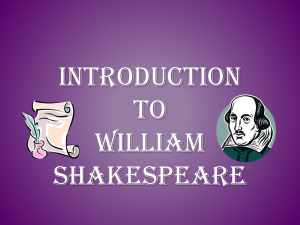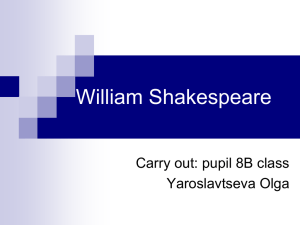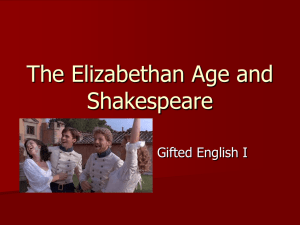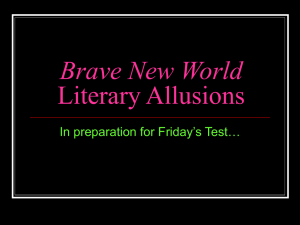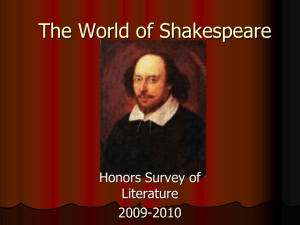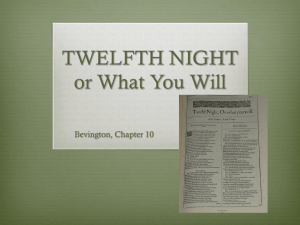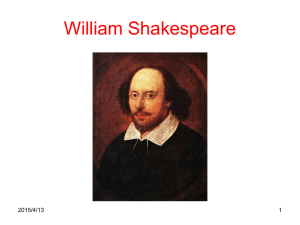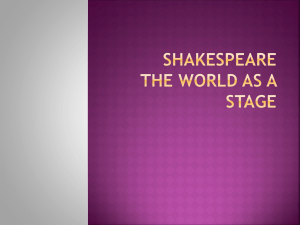Shakespeare and His Interpreters
advertisement
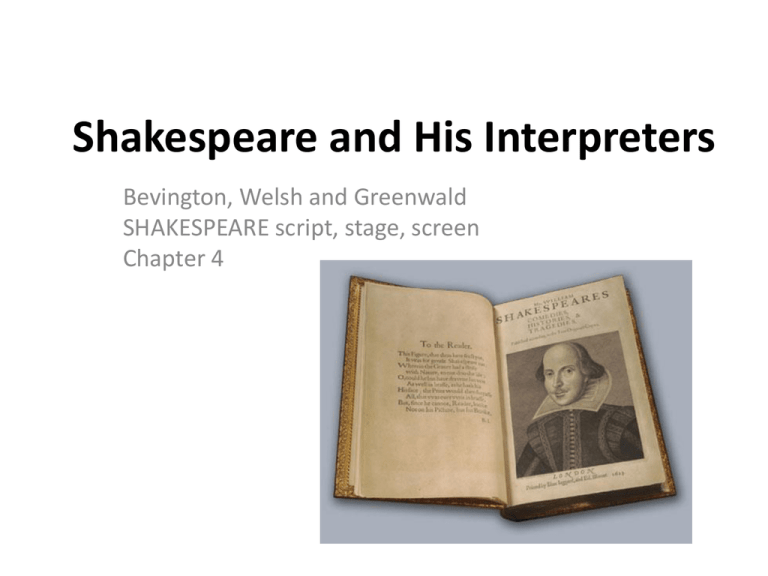
Shakespeare and His Interpreters Bevington, Welsh and Greenwald SHAKESPEARE script, stage, screen Chapter 4 The spectrum of interpretive possibilities • Reviewers, critics, directors, and actors all bring their own backgrounds, prejudices and personal experiences • Jonathan Miller: With the passage of time Shakespeare’s plays have quite properly assumed the status of myths... The director has a responsibility to interpret these myths • Richard David: Miller’s imaginative distortions are a form of translation...a process if diminution • Both men are talking about “concept” directing Elizabethan and Jacobean Interpretations • No professional theatre critics...Acting companies did not employ directors...Our accounts today are based upon writings of diarists and theatregoers • Simon Forman, an astrologer and theatregoer • Henry Jackson, an Oxford don • Acting styles were not what we’d recognize today • Actors spoke rapidly • Gestures were conventional • Transitions were quick because of lack of scenery • The audience consisted of “practiced listeners” • No female actors Shakespeare enjoyed a strong reputation as a dramatist, unusual for his time according to contemporary authors like Francis Meres and Ben Jonson. Jonson viewed Shakespeare as an untutored genius writing undisciplined if brilliant plays for an unrefined age. Restoration Age: The Rise of the Actor-Manager Samuel Pepys, the most notable diarist of the age, saw and wrote about numerous Shakespeare revivals Restoration Age: The Rise of the Actor-Manager Shakespeare’s plays were adapted to neoclassical ideals. Most notable in John Dryden’s ALL FOR LOVE (1678) Restoration Age: The Rise of the Actor-Manager Performance was licensed to two companies in London and gave rise to powerful actormanagers. The first licenses were awarded to Thomas Killigrew and William Davenant Restoration Age: The Rise of the Actor-Manager Thomas Betterton (16351710) succeeded Davenant in 1668. He consolidated the two licenses at Drury Lane in 1682...As an actor, he is noted for his formal acting style. Plays, like Nahum Tate’s adaptation of KING LEAR, changed the endings of Shakespeare’s plays. The actress emerged on the stage, the most famous Nell Gwynn, known also as the King’s mistress. 18th Century: Neoclassical Rules and Tastes Carried on the neoclassical traditions of the Restoration...also known as the Augustan Age or “The Age of Reason.” Shakespeare was still considered a “native” English writer whose “natural” genius needed the polish of refinement. Alexander Pope was one of the great critics of the age. 18th Century • David Garrick (1717-1779) the great actor-manager of the day • Theatre buildings grew in size and capacity. Under his leadership, which begag in 1740, Drury Lane grew to a capacity of 2000. • Garrick organized the Shakespeare Jubilee at Stratford-on-Avon • As was common in the day, Garrick and others, produced plays that were “altered” 18th Century Garrick as Richard III by Hogarth, 1745 18th Century Acting An age of great acting...in addition to Garrick, the most famous actors of the age included Charles Macklin, James Quin, Hannah Pritchard, Peg Woffington and Susanna Cibber. (Pictured, Macklin as Shylock.) Peg Woffington 19th Century--Character Criticism and Spectacle • Generally, the early 19th century was a period of decline in the English theatre • The great poets of the Romantic period (Wordsworth, Keats, Byron) did not write for the stage • Romantic critics considered Shakespeare in their terms, as a poet and not as a man of the theatre 19th Century--Character Criticism and Spectacle Productions were treated as opera is in our time: – Lavish productions – Huge spectacles – Large auditoriums – High declamatory style Great Shakespearean actors of the day were international stars. They included… 19th Century EDMUND KEAN as Richard III 19th Century William Charles Macready Charles Kemble as Romeo 19th Century Actors Edwin, John Wilkes and Junius Brutus Booth 19th Century Actors Henry Irving Ellen Terry as Lady Macbeth 19th Century Actors Sarah Bernhardt (in her coffin) Eleanor Duse Early 20th Century Lavish spectacles were popular at turn of century under the influence of Macready and Irving. Herbert Beerbohm Tree was one of the outstanding actormanagers of the Edwardian age. Tree’s famous production of A MIDSUMMER NIGHT’S DREAM Early 20th Century William Poel founded the Elizabethan Stage Society to return Shakespeare to its roots. It influenced Harley Granville-Barker, Tyrone Guthrie and Lilian Baylis at the Old Vic. (In 1964, the Old Vic became the National Theatre.) Pictured above is Poel’s production of Hamlet. Early 20th Century The 20th century saw the rise of the “director” New ways of viewing Shakespeare viewed his characters in modern terms...in Freudian terms, for example Mid-20th Century Historical criticism (professed by F.R. Leavis and others) sought to present a close reading of Shakespeare unencumbered by biographical or historical information. This approach heavily influenced modern directors like Sir Peter Hall (pictured) Mythological criticism, as argued by Northrup Frye and others, suggests that Shakespeare’s plays well up from our primal associations with nature and seasons. Post-WW II: Marxism and Existentialism Jan Kott published Shakespeare Our Contemporary (1964) His work strongly influenced Peter Brook. Post-WW II: Marxism and Existentialism Kott was influenced by the epic theatre of Bertolt Brecht Counter-culture movement of the 1960s further influenced approaches to Shakespeare Contemporary Criticism and Interpretation: Deconstruction, New Historicism and Feminism • These movements have encouraged an openness to the other, an acceptance of multiplicity of perspectives--ethnic, feminist, gay • Shakespeare’s plays are elastic--exceptionally responsive to new questions and new approaches Shakespeare also borrowed and adapted • The only original plays in the are LOVE’S LABOURS LOST, A MIDSUMMER NIGHT’S DREAM and THE TEMPEST • Sometimes, as in KING LEAR and MUCH ADO ABOUT NOTHING, he combined stories from two sources ADAPTATIONS, SPIN-OFFS and PARODIES • First memorable adaptation was Dryden’s ALL FOR LOVE (1678) that was based upon ANTONY AND CLEOPATRA • Classical composers have adapted many of Shakespeare’s plays such as Verdi’s OTELLO (1887) and FALSTAFF (1893) • Mendelssohn wrote famous incidental music for an 1843 performance of A MIDSUMMER NIGHT’S DREAM, most famously the wedding march ADAPTATIONS, SPIN-OFFS and PARODIES 1957 - WEST SIDE STORY follows the plot outline although it does not use any of the dialogue of ROMEO AND JULIET. ADAPTATIONS, SPIN-OFFS and PARODIES Cole Porter’s KISS ME KATE (1947) FILM SPIN-OFFS MY OWN PRIVATE IDAHO (1991) based on Henry IV plays FILM SPIN-OFFS TEMPEST (1981) an inventive tale by Paul Mazursky FILM SPIN-OFFS BROKEN LANCE (1954), A THOUSAND ACRES (1997), KING OF TEXAS (2002) are all based upon KING LEAR FILM SPIN-OFFS THRONE OF BLOOD (1957) is a Japanese retelling of MACBETH SATIRES AND PARODIES • California gold miners presented oddities like Romeo and Suet: or, A Cup o’ Pizen and Odd Fellow, the Boor of Venice • During the Vietnam years, Lyndon Johnson was mocked in a play called Macbird! TOM STOPPARD • Tom Stoppard had successes with Dogg’s Hamlet and Cahoot’s Macbeth in addition to Rosencrantz and Guildenstern Are Dead • He also co-scripted SHAKESPEARE IN LOVE, based on Shakespeare’s life and ROMEO AND JULIET. It won the Oscar for best picture in 1997. ON TELEVISION Sid Caesar’s YOUR SHOW OF SHOWS often spoofed Shakespeare in sketches written by Mel Brooks A famous episode of Moonlighting starring Bruce Willis and Cybill Shepherd spoofed THE TAMING OF THE SHREW ON TELEVISION A Happy Days episode featured Fonzie as Hamlet SLINGS AND ARROWS In recent years, the Showtime comedy Slings and Arrows centered on a single play each season (Hamlet, Macbeth, King Lear) as produced by an imaginary Canadian Shakespeare festival. Shakespeare has become familiar enough to find a place in popular culture.
